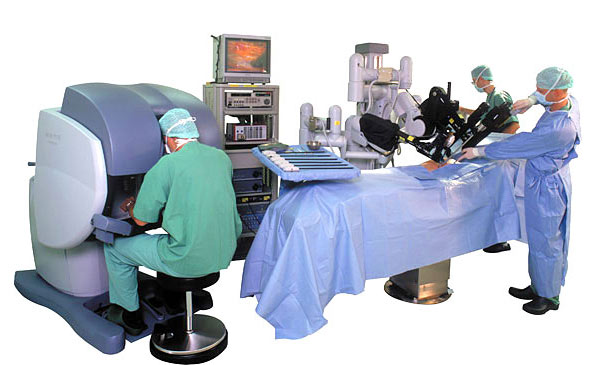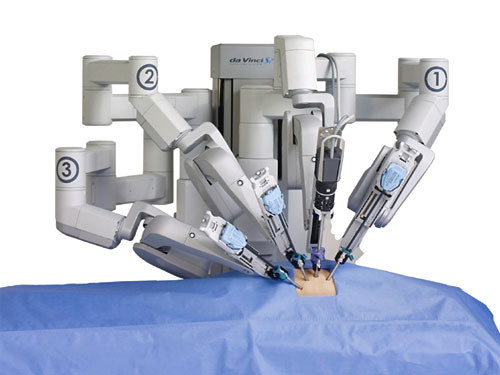Da Vinci Surgical Robot
Da Vinci Surgical Robot
Source:
http://www.davincisurgery.com/
 The da Vinci Surgical System is a sophisticated robotic platform designed to expand the surgeon's capabilities and offer a state-of-the-art minimally invasive option for major surgery.
The da Vinci Surgical System is a sophisticated robotic platform designed to expand the surgeon's capabilities and offer a state-of-the-art minimally invasive option for major surgery.
With da Vinci, small incisions are used to insert miniaturized wristed instruments and a high-definition 3D camera. Seated comfortably at the da Vinci console, your surgeon views a magnified, high-resolution 3D image of the surgical site inside your body.
 At the same time, the latest robotic and computer technologies scale, filter and seamlessly translate your surgeon's hand movements into precise micro-movements of the da Vinci instruments.
At the same time, the latest robotic and computer technologies scale, filter and seamlessly translate your surgeon's hand movements into precise micro-movements of the da Vinci instruments.
Although it is often called a 'robot', the da Vinci System cannot move or operate on its own your surgeon is 100% in control.
 Minimally Invasive Surgery (MIS) is surgery typically performed through small incisions, or operating ports, rather than large incisions, resulting in potentially shorter recovery times, fewer complications, reduced hospitalization costs and reduced trauma to the patient. While MIS has become standard-of-care for particular surgical procedures, it has not been widely adopted for more complex or delicate procedures - for example, prostatectomy and mitral valve repair.
Minimally Invasive Surgery (MIS) is surgery typically performed through small incisions, or operating ports, rather than large incisions, resulting in potentially shorter recovery times, fewer complications, reduced hospitalization costs and reduced trauma to the patient. While MIS has become standard-of-care for particular surgical procedures, it has not been widely adopted for more complex or delicate procedures - for example, prostatectomy and mitral valve repair.
 Although seated at a console a few feet away from the patient, the surgeon views an actual image of the surgical field while operating in real-time, through tiny incisions, using miniaturized, wristed instruments. At no time does the surgeon see a virtual image or program/command the system to perform any maneuver on its own/outside of the surgeon's direct, real-time control.
Although seated at a console a few feet away from the patient, the surgeon views an actual image of the surgical field while operating in real-time, through tiny incisions, using miniaturized, wristed instruments. At no time does the surgeon see a virtual image or program/command the system to perform any maneuver on its own/outside of the surgeon's direct, real-time control.
 The da Vinci Surgical System can theoretically be used to operate over long distances. This capability, however, is not the primary focus of the company and thus is not available with the current da Vinci Surgical System.
The da Vinci Surgical System can theoretically be used to operate over long distances. This capability, however, is not the primary focus of the company and thus is not available with the current da Vinci Surgical System.
 The product is called "da Vinci" in part because Leonardo da Vinci invented the first robot. He also used unparalleled anatomical accuracy and three-dimensional details to bring his masterpieces to life. The da Vinci Surgical System similarly provides physicians with such enhanced detail and precision that the System can simulate an open surgical environment while allowing operation through tiny incisions.
The product is called "da Vinci" in part because Leonardo da Vinci invented the first robot. He also used unparalleled anatomical accuracy and three-dimensional details to bring his masterpieces to life. The da Vinci Surgical System similarly provides physicians with such enhanced detail and precision that the System can simulate an open surgical environment while allowing operation through tiny incisions.

 The da Vinci Surgical System is a sophisticated robotic platform designed to expand the surgeon's capabilities and offer a state-of-the-art minimally invasive option for major surgery.
The da Vinci Surgical System is a sophisticated robotic platform designed to expand the surgeon's capabilities and offer a state-of-the-art minimally invasive option for major surgery. At the same time, the latest robotic and computer technologies scale, filter and seamlessly translate your surgeon's hand movements into precise micro-movements of the da Vinci instruments.
At the same time, the latest robotic and computer technologies scale, filter and seamlessly translate your surgeon's hand movements into precise micro-movements of the da Vinci instruments. Minimally Invasive Surgery (MIS) is surgery typically performed through small incisions, or operating ports, rather than large incisions, resulting in potentially shorter recovery times, fewer complications, reduced hospitalization costs and reduced trauma to the patient. While MIS has become standard-of-care for particular surgical procedures, it has not been widely adopted for more complex or delicate procedures - for example, prostatectomy and mitral valve repair.
Minimally Invasive Surgery (MIS) is surgery typically performed through small incisions, or operating ports, rather than large incisions, resulting in potentially shorter recovery times, fewer complications, reduced hospitalization costs and reduced trauma to the patient. While MIS has become standard-of-care for particular surgical procedures, it has not been widely adopted for more complex or delicate procedures - for example, prostatectomy and mitral valve repair.
 Although seated at a console a few feet away from the patient, the surgeon views an actual image of the surgical field while operating in real-time, through tiny incisions, using miniaturized, wristed instruments. At no time does the surgeon see a virtual image or program/command the system to perform any maneuver on its own/outside of the surgeon's direct, real-time control.
Although seated at a console a few feet away from the patient, the surgeon views an actual image of the surgical field while operating in real-time, through tiny incisions, using miniaturized, wristed instruments. At no time does the surgeon see a virtual image or program/command the system to perform any maneuver on its own/outside of the surgeon's direct, real-time control.
 The da Vinci Surgical System can theoretically be used to operate over long distances. This capability, however, is not the primary focus of the company and thus is not available with the current da Vinci Surgical System.
The da Vinci Surgical System can theoretically be used to operate over long distances. This capability, however, is not the primary focus of the company and thus is not available with the current da Vinci Surgical System.
 The product is called "da Vinci" in part because Leonardo da Vinci invented the first robot. He also used unparalleled anatomical accuracy and three-dimensional details to bring his masterpieces to life. The da Vinci Surgical System similarly provides physicians with such enhanced detail and precision that the System can simulate an open surgical environment while allowing operation through tiny incisions.
The product is called "da Vinci" in part because Leonardo da Vinci invented the first robot. He also used unparalleled anatomical accuracy and three-dimensional details to bring his masterpieces to life. The da Vinci Surgical System similarly provides physicians with such enhanced detail and precision that the System can simulate an open surgical environment while allowing operation through tiny incisions.